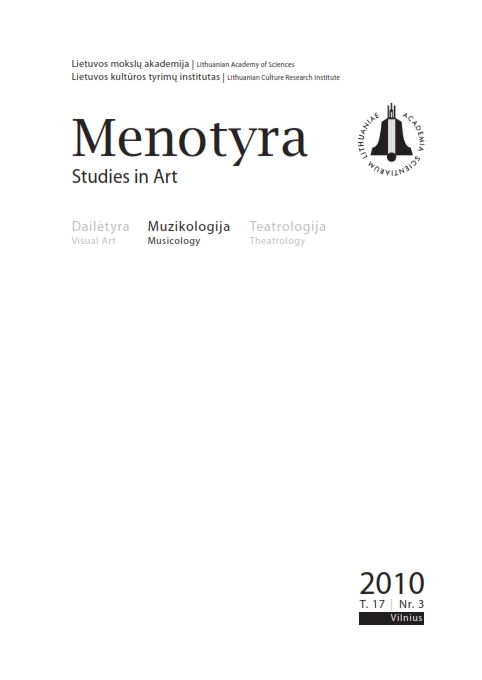Muzikos erdvės kompozicinės artikuliacijos aspektai
Aspects of compositional articulation of musical space
Author(s): Mārtiņš ViļumsSubject(s): Music, Phenomenology, Sociology of Art
Published by: Lietuvos mokslų akademijos leidykla
Keywords: music in space; space in music; space of score; perception of music; sound gravity; sound energy; sounds as moving objects; imagining and music; musical texture; musical Gestalt;
Summary/Abstract: Typically, space is described as a three-dimensional object. With the help of these dimensions, all objects and the distances among them in space can be determined (Merriam-Webster’s dictionary). Space, functionally, exists as systematical structures for indicating our experience and cannot be defined independently of human consciousness. Physically and phenomenologically, space is connected with time as the objects’ movement and events and creates the space-time continuum (Bunnin, Yu 2004: 652). Spatial perception invokes exterceptive (vision, smell, touch, taste, hearing), interceptive (internal organs of the body, sensation) and proprioceptive (vestibular sensation) sensorial systems (Stein, Stanford 1999: 409; Colby 1999: 785–786; Галеев 2005). For any phenomenon of the external world, a human relies on these sensorial systems which provide the possibilities of space-time recognition (Фомин 1993: 28), although the internal – mental – dimension of perception exists even beside the physical world and has a self-contained space-time universe (Smithies 2003: 55).There are three fundamental compositional situations of spatial implement depending on which piece can be understood:a) as music in space;b) as space in music;c) as space of score.The associative influence of the objects and movements of the physical world involves three basic integrated properties into the perceptional context of musical processes:1) sounds, which seem to have spatial positions and directions of motion;2) intensity-energy of sounds;3) inertia-gravity of sounds.The correlation among space, energy and gravity as a perceptual association of musical processes is closely connected with the analogy of the objects and movements of the physical world: it is necessary to have energy for resisting earth gravity and reaching a particular point / place in space.Human ability to interpret musical processes as a kind of building of the external world and mental imagination is reliant on cross-modal connections between sensorial systems. The visual reconstruction of perceptual musical forms is realized throughout musical texture – as a graphical (two-dimensional) external dimension (pitch height as the vertical position, duration as the horizontal position) and an internal (timbre-color and intensity-distance) specification of implemental possibilities.The perception of musical texture (as we hear it during the listening process) correlates with the graphical image of a piece, although the limitation of perceptual possibilities confuses and complicates the visual imagination of the score and the musical processes. Thus, perceptually, musical transmission from the score to the imagination of sound shapes cannot be extracted as an interpretation of graphical texture (as a kind of musical example) directly, but it must be recognized through a range of significances of musical symbols. The visualization of sounds is led by the limited hearing possibilities to recognize the complexity of musical structures. Therefore relationships between music and score in the case of verticality are hard to predict, while the dimension of time in the case of visual-horizontal perspective (like in the spatial-vertical dimension) retains the proportional components quite well.The perceptual levels of space in score and space in music display the mental recognition forms of space and build up a complex of compositional solution. Hence comes the importance of instrumental properties for the analysis of music.
Journal: Menotyra
- Issue Year: 17/2010
- Issue No: 3
- Page Range: 263-281
- Page Count: 19
- Language: Lithuanian

